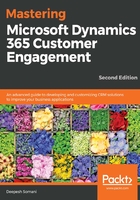
上QQ阅读APP看书,第一时间看更新
Entities in Dynamics 365
Dynamics 365 provides revenue management and goal management processes, which can be easily customized to suit the business process of an organization. The following are the entities provided by Dynamics 365:
- Leads, Contact, and Account: These entities are already listed as a part of the Marketing module. They represent the same business actors in the Sales module and in the Marketing module.
- Opportunities: This represents an interaction with a lead that may be converted into a revenue-generating avenue for the organization.
- Competitors: These represent third-party organizations that are competing with the organization for the services required by the customer.
- Product: This may represent a resource, service, or item offered by the organization for the services of the client.
- Product unit: This represents the possible unit of groups in which the product is available.
- Price list: This identifies the price that the organization charges the client for its products. Dynamics 365 allows us to configure different prices for different regions/countries.
- Currency: Each price list is associated with the currency of the underlying region/country.
- Quotes: Dynamics CRM captures the list of product line items, which the company offer to the client as a quote. Along with the product information, it also captures the contact details of the prime contact, shipping information, and discount, if any.
- Invoices: As in the general sales cycle, when the customer accepts the terms and conditions mentioned in the quote, the quote is converted into an invoice. Dynamics CRM captures the same information as that of the quote; however, it just acts as a formal contract between the organization and the customer.
- Goals: Dynamics 365 allows the organization to capture preset targets in terms of won opportunities, revenue generated, and so on, which a sales representative should strive to adhere to.
The following is a sequence diagram explaining the interaction involved in the Sales life cycle within Dynamics 365:
